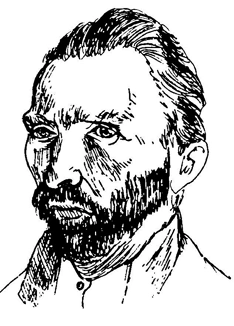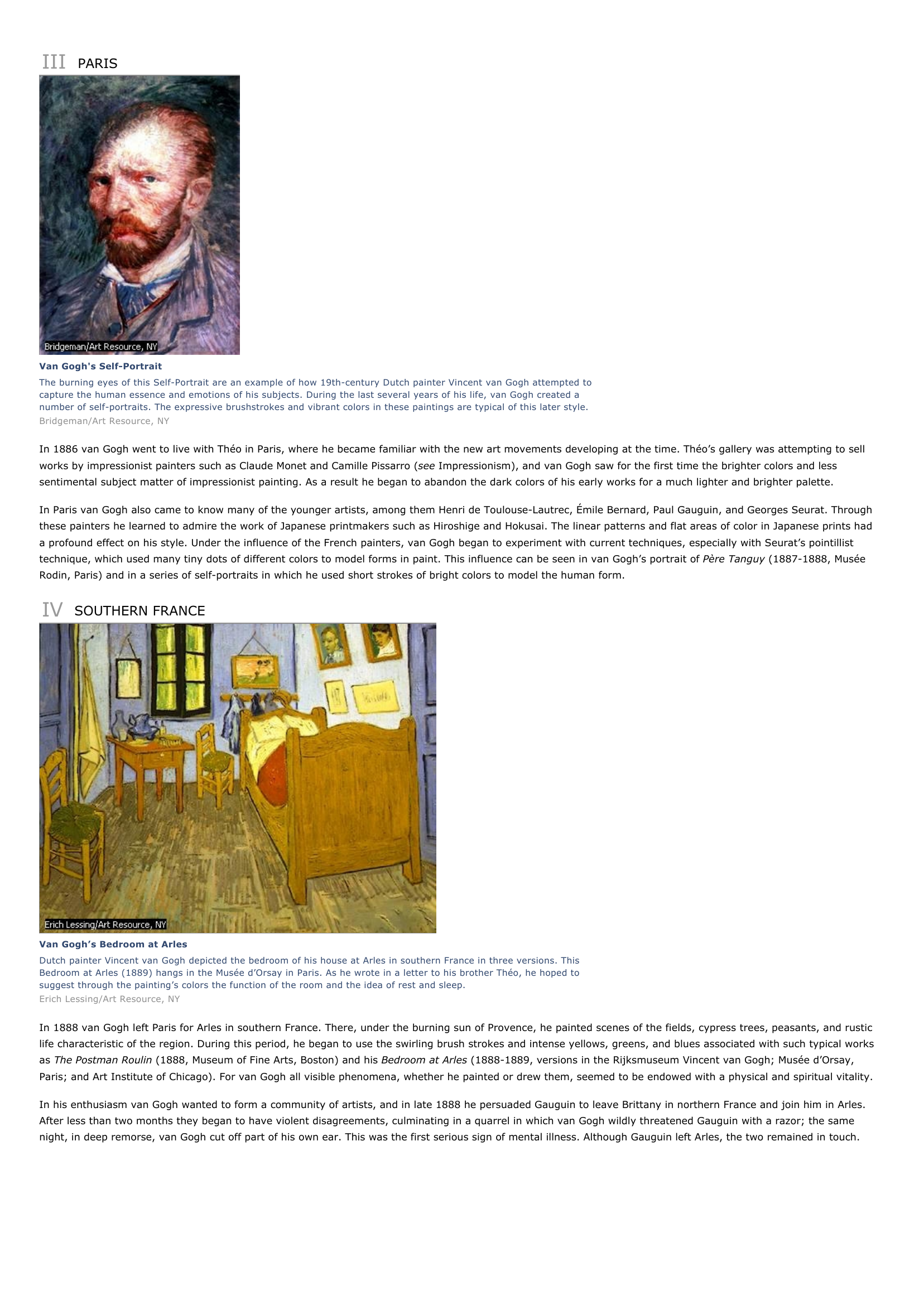Vincent van Gogh I INTRODUCTION Church at Auvers by Van Gogh Dutch artist Vincent van Gogh spent the last months of his life in Auvers-sur-Oise, near Paris, under the care of Dr.
Publié le 12/05/2013

Extrait du document


«
III PARIS
Van Gogh's Self-PortraitThe burning eyes of this Self-Portrait are an example of how 19th-century Dutch painter Vincent van Gogh attempted tocapture the human essence and emotions of his subjects.
During the last several years of his life, van Gogh created anumber of self-portraits.
The expressive brushstrokes and vibrant colors in these paintings are typical of this later style.Bridgeman/Art Resource, NY
In 1886 van Gogh went to live with Théo in Paris, where he became familiar with the new art movements developing at the time.
Théo’s gallery was attempting to sellworks by impressionist painters such as Claude Monet and Camille Pissarro ( see Impressionism), and van Gogh saw for the first time the brighter colors and less sentimental subject matter of impressionist painting.
As a result he began to abandon the dark colors of his early works for a much lighter and brighter palette.
In Paris van Gogh also came to know many of the younger artists, among them Henri de Toulouse-Lautrec, Émile Bernard, Paul Gauguin, and Georges Seurat.
Throughthese painters he learned to admire the work of Japanese printmakers such as Hiroshige and Hokusai.
The linear patterns and flat areas of color in Japanese prints hada profound effect on his style.
Under the influence of the French painters, van Gogh began to experiment with current techniques, especially with Seurat’s pointillisttechnique, which used many tiny dots of different colors to model forms in paint.
This influence can be seen in van Gogh’s portrait of Père Tanguy (1887-1888, Musée Rodin, Paris) and in a series of self-portraits in which he used short strokes of bright colors to model the human form.
IV SOUTHERN FRANCE
Van Gogh’s Bedroom at ArlesDutch painter Vincent van Gogh depicted the bedroom of his house at Arles in southern France in three versions.
ThisBedroom at Arles (1889) hangs in the Musée d’Orsay in Paris.
As he wrote in a letter to his brother Théo, he hoped tosuggest through the painting’s colors the function of the room and the idea of rest and sleep.Erich Lessing/Art Resource, NY
In 1888 van Gogh left Paris for Arles in southern France.
There, under the burning sun of Provence, he painted scenes of the fields, cypress trees, peasants, and rusticlife characteristic of the region.
During this period, he began to use the swirling brush strokes and intense yellows, greens, and blues associated with such typical worksas The Postman Roulin (1888, Museum of Fine Arts, Boston) and his Bedroom at Arles (1888-1889, versions in the Rijksmuseum Vincent van Gogh; Musée d’Orsay, Paris; and Art Institute of Chicago).
For van Gogh all visible phenomena, whether he painted or drew them, seemed to be endowed with a physical and spiritual vitality.
In his enthusiasm van Gogh wanted to form a community of artists, and in late 1888 he persuaded Gauguin to leave Brittany in northern France and join him in Arles.After less than two months they began to have violent disagreements, culminating in a quarrel in which van Gogh wildly threatened Gauguin with a razor; the samenight, in deep remorse, van Gogh cut off part of his own ear.
This was the first serious sign of mental illness.
Although Gauguin left Arles, the two remained in touch..
»
↓↓↓ APERÇU DU DOCUMENT ↓↓↓
Liens utiles
- The Church at Auvers-sur-Oise, 1890 - Vincent Van Gogh
- Wheatfield Under Threatening Skies with Crows, Auvers-sur-Oise 1890 - Vincent Van Gogh
- Landscape in the Rain, Auvers-sur-Oise 1890 - Vincent Van Gogh
- Marguerite Gachet at the Piano, Auvers-sur-Oise 1890 - Vincent Van Gogh
- Vincent VAN GOGH: L'ÉGLISE D'AUVERS-SUR-OISE.





